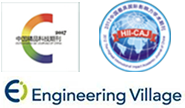Abstract:
Taking T800 carbon fiber/X850 epoxy composites T-shaped workpiece as the combined object, using COMSOL Multiphysics simulation software, the finite element simulation model reflecting the microwave curing of single feed resonant cavity of composites workpiece was established, and the distribution laws of electromagnetic field, temperature field and curing degree field inside the microwave cavity and workpiece and their mapping relationship with microwave input power were studied. The results show that there are opposite electric field intensity distributions in the microwave cavity and the workpiece. In the composite workpiece, the electric field intensity in the area far away from the microwave feed port is higher than that near the feed port, and there is a strong tip effect in the angular area of the workpiece; With the increase of microwave input power, the electric field intensity in the microwave cavity and the workpiece increases. The maximum electric field intensity appears on the upper and lower surfaces, and the temperature of the lower surface is significantly higher than that of the upper surface; Increasing the microwave input power will lead to the rapid temperature rise of the workpiece, and then induce the gradient of temperature and curing degree. In the middle and late stage of heating up, the gradient of temperature and curing degree is obvious. This study recommends that the microwave input power should be controlled within 500 W.


 下载:
下载: